The next Steve Jobs will be a farmer.
Forget apps, wearable tech and silicon valley. The next big thing is what we eat and where we produce it. Four key drivers are turning Fruit & Veggies into the most exciting sector on the block. And that’s not even counting the fact that we need to feed a burgeoning world population with significant health challenges. Find out below how the potent mix of unparalleled innovation and marketing infusion is creating fantastic entrepreneurial opportunities and who is in the unexpected best position to reap the rewards. Let me take you on a rollercoaster from VC-funded broccoli brands via 3d printed food to the farmground of the future: the sea.
Wasserbombe. For decades, innovation in this sector was mostly urban myth, like square tomatoes. Chiquita was the only brand that I can recall. If you heard something about vegetables, it was usually bad: the Dutch (or rather: the Germans) have only recently recovered from the ‘Wasserbombe’ trauma. My fellow countrymen had been shipping shiny but watery, tasteless tomato-lookalikes to our German neighbours for years.

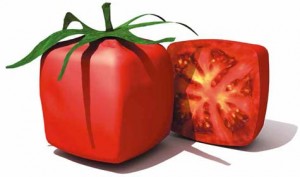 One day the Germans decided they had suffered enough culinary abuse. The boycot that followed was tough but ultimately saved the Dutch vegetable breeding industry, making it an economic powerhouse.
One day the Germans decided they had suffered enough culinary abuse. The boycot that followed was tough but ultimately saved the Dutch vegetable breeding industry, making it an economic powerhouse.
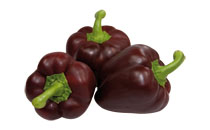 Sexy Seeds. When my wife became the legal counsel for Enza Zaden, one of the world’s leading vegetable breeding companies, I flipped through their catalogue in her first week on the job and I could not believe my eyes. Why was I not enjoying all these wonderful varieties, colours, innovations and design vegetables in my kitchen ? I decided to dig deeper.
Sexy Seeds. When my wife became the legal counsel for Enza Zaden, one of the world’s leading vegetable breeding companies, I flipped through their catalogue in her first week on the job and I could not believe my eyes. Why was I not enjoying all these wonderful varieties, colours, innovations and design vegetables in my kitchen ? I decided to dig deeper.
Broccoli.com. When Enza invited me to speak at their 75-year anniversary I explored the rise of marketing in this sector in ‘Broccoli.com: the future of marketing in fruit and veggies (presentation below) and challenged four teams of ambitious students to come up with buzzable new innovations and couple them with the latest marketing techniques.
Paradigm shift. Since then I realized that the world of fruit and vegetables is undergoing a paradigm shift. Four drivers of change are fueling this shift:
- From Boring to Buzzable
- Marketing Mania
- Private Production
- Game Changers
As a result, we will see veggies fast becoming more buzzable and existing and new players fighting over the added value they will create. Hence the question:
Who will become the Apple of veggies* ?
I strongly believe it will not be one of the usual suspects. At the end of this blog I will share where I think the next Steve will come from. As a cook, innovator, marketer and entrepreneur, I am very excited about all the new possibilities in the world of F&V. After reading this blog, I hope you will be too.
*I didn’t even see the pun while writing this. Did you catch it ?
From Commodity to Tasty Tom For centuries fruit and veggies were either important to the traditional local cuisine and always of good quality – think mediterranean countries – or simply unimportant – as in my home country, The Netherlands. In neither case would you need a brand on your tomato as a sign of quality as brands were designed to do since 1600 years ago. But with Spanish tomatoes no longer guaranteed to have seen enough Andalusian sun and more and more consumers becoming more critical about their veggies, the first branded tomato varieties with better, more predictable qualities were created to fill the gap.
 Let’s Pivot that Broccoli ! In the world of business, pivoting means you’re adapting your proposition to follow the market. With visionaries like Alain Passard wetting our appetite, consumers are now warming to all kinds of ‘tweaked’ versions of what we already know, like crossovers Broccolini and Mineola that combine the qualities (visual, taste, texture) of existing types. Timing is everything: the Mineola has been around since the 1930’s but is only now gaining speed.
Let’s Pivot that Broccoli ! In the world of business, pivoting means you’re adapting your proposition to follow the market. With visionaries like Alain Passard wetting our appetite, consumers are now warming to all kinds of ‘tweaked’ versions of what we already know, like crossovers Broccolini and Mineola that combine the qualities (visual, taste, texture) of existing types. Timing is everything: the Mineola has been around since the 1930’s but is only now gaining speed.
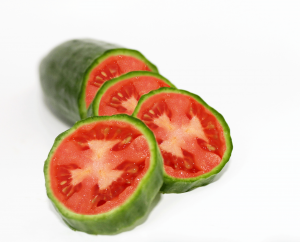 Convenience will be a big innovation theme. Think PureHeart seedless watermelons, EazyLeaf saladcrops that fall apart when you just look at them. Expect fruits and vegetables to be stripped of everything that makes them less desirable: skin, seeds, bitterness, the need to cook or wash them. And since we’re always mixing tomato with cucumber, why not combine them into a new species ?
Convenience will be a big innovation theme. Think PureHeart seedless watermelons, EazyLeaf saladcrops that fall apart when you just look at them. Expect fruits and vegetables to be stripped of everything that makes them less desirable: skin, seeds, bitterness, the need to cook or wash them. And since we’re always mixing tomato with cucumber, why not combine them into a new species ?
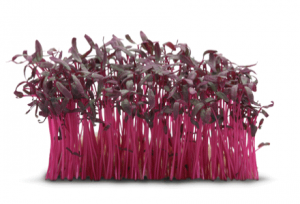 Custom Designed – Most food innovations start in restaurants. Dutch company Koppert Cress is making tiny herby plants incredibly sexy and buzzable that allows restaurants to create new – and custom if they want – visual and taste adventures around them. Supermarket chains are collaborating with seed companies and growers to get their custom varieties of a snack cucumber or tomato. Australian supermarket chain Coles went one step further and created a new brand for a range called Hatters Vegetables that combines seasonality & ‘forgotten veggies’.
Custom Designed – Most food innovations start in restaurants. Dutch company Koppert Cress is making tiny herby plants incredibly sexy and buzzable that allows restaurants to create new – and custom if they want – visual and taste adventures around them. Supermarket chains are collaborating with seed companies and growers to get their custom varieties of a snack cucumber or tomato. Australian supermarket chain Coles went one step further and created a new brand for a range called Hatters Vegetables that combines seasonality & ‘forgotten veggies’.
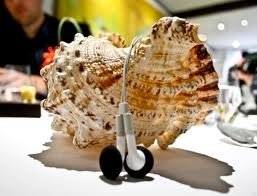 The Sound of Sea. Some chefs innovate not just the food but also how you eat it. The Fat Duck’s celebrity chef Blumenthal explains how listening to the sounds of the sea from an shellfish iPod while eating seafood will make your tasting experience more intense.
The Sound of Sea. Some chefs innovate not just the food but also how you eat it. The Fat Duck’s celebrity chef Blumenthal explains how listening to the sounds of the sea from an shellfish iPod while eating seafood will make your tasting experience more intense.
 What’s Next ? The time of ‘ added value’ innovation has arrived for F&V. Quality, convenience, functionality, ‘looks’. Any fruit or vegetable that frequently disappoints will see a branded variety that is consistently good. Partially because it’s a better variety, partially because it won’t be sold when it’s not the right time. Expect endless varieties, crossovers with something extra and introductions from other continents to enter the market and supermarkets to experiment with them. Although many launches will fail due to a lack of marketing support and/or fighting over rights between seed companies, growers and retailers, this will not slow down the pace of innovation. Customization will move from restaurants to retailers and innovation will start to come from entrepreneurs and customer-centric companies strange to the F&V scene. I predict we will soon see the first Kickstarter-funded F&V innovations. Oooh yeah, fennel. Fennel is going to be big. Trust me, it’s the killer app of veggies.
What’s Next ? The time of ‘ added value’ innovation has arrived for F&V. Quality, convenience, functionality, ‘looks’. Any fruit or vegetable that frequently disappoints will see a branded variety that is consistently good. Partially because it’s a better variety, partially because it won’t be sold when it’s not the right time. Expect endless varieties, crossovers with something extra and introductions from other continents to enter the market and supermarkets to experiment with them. Although many launches will fail due to a lack of marketing support and/or fighting over rights between seed companies, growers and retailers, this will not slow down the pace of innovation. Customization will move from restaurants to retailers and innovation will start to come from entrepreneurs and customer-centric companies strange to the F&V scene. I predict we will soon see the first Kickstarter-funded F&V innovations. Oooh yeah, fennel. Fennel is going to be big. Trust me, it’s the killer app of veggies.
Marketing is the key to this sector’s future. Although innovative products will help, their stories need to be told and our behaviour towards them has to be ‘educated’. And since the seed companies and growers have always had their heads in the soil and not around their end-customers wishes and needs, the big marketing push is not going to come from them. It’s entrepreneurs like Innocent Drinks who taught the world how to tell a fruity story. I expect other startups and retailers – who have always dealt with marketing – to take the initial lead.
Almost Forgotten Stories. When Seth Godin wrote ‘All Marketers are liars’ storytelling was already becoming a favourite tool for marketers. Entrepreneurs are using it to reintroduce ‘long forgotten’ varieties in rice and grain and layering a mythical story on top of them. Forgotten veggies are already the lovechild of restaurateurs and cookbook writers and someone will (or already has) create a branded variety that tells a wonderful tale.
The secret of the rare Wizard of Laos mixture, made of three distinct rice varieties, was discovered by farmers in Laos during the Kha period
Superfoods are like the forgotten veggies. The Goji’s and Quinoa’s of the world have been around for centuries. But their mythical qualities have only recently been discovered by the developed economies whose spoiled citizens are yearning for the latest health craze and inspirational story to come with it. This type of category marketing will take a big flight, with ever more unlikely claims and secrets competing for your attention.
“Superfoods is a marketing term used to describe foods with supposed health benefits. Many nutrition scientists dispute these claims…”
What the heck is hummus ? When you introduce a known fruit or veggie into an new region you have a lot of educating and ‘positioning’ to do. A friend of mine is introducing the ‘Yogi‘ brand to help Westerners finally appreciate dates. Below you can see how the brave people of Sabra are trying to get hummus on the American people’s menu. They found the fastest way to the tummies of Americans is to become the snack you eat while watching american football.
Fruity Packaging. Some take storytelling to the extreme. This fantastic campaign shows how you can turn fruit into the packaging and the message about the product itself.
 Bakery Tweets & Carrot Drones. Albion bakery became famous in 2009 when it started tweeting when their cupcakes or other baked goodies were ready to be picked up using BakerTweet. An irresistible story about fruit and veggies is that it grows: if artisan veggie shops would tweet video images of drones circling shiny carrot fields glowing in the sun we’ll be hopping over like it’s a poppy field.
Bakery Tweets & Carrot Drones. Albion bakery became famous in 2009 when it started tweeting when their cupcakes or other baked goodies were ready to be picked up using BakerTweet. An irresistible story about fruit and veggies is that it grows: if artisan veggie shops would tweet video images of drones circling shiny carrot fields glowing in the sun we’ll be hopping over like it’s a poppy field.
Buzzing Better Behaviour. Marketing is fast becoming a behavioural science, designed to influence our buying behaviour. With fruit & veggies being seen as ‘good behaviour’, there is a huge opportunity in using marketing to help us eat more veggies. Where some food fanatics choose negative emotions to combat deadly pasta and killer-bread, I believe you change behaviour with positive triggers, as I described before.
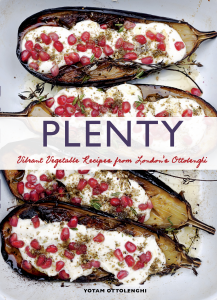 My name is Lenghi. Otto Lenghi. A great example of positive triggers for veggies is Ottolenghi (and no, I know Otto is not his first name). He not just celebrates food and vegetables, he even helps Middle Eastern relations by writing a cookbook with an Arab. To top it off, he refuses to be held hostage by vegetarians and routinely suggests meat and fish to go with his lovely dishes. The result ? At a recent dinner party, the host of the evening reassuringly told us: everything is Ottolenghi tonight.
My name is Lenghi. Otto Lenghi. A great example of positive triggers for veggies is Ottolenghi (and no, I know Otto is not his first name). He not just celebrates food and vegetables, he even helps Middle Eastern relations by writing a cookbook with an Arab. To top it off, he refuses to be held hostage by vegetarians and routinely suggests meat and fish to go with his lovely dishes. The result ? At a recent dinner party, the host of the evening reassuringly told us: everything is Ottolenghi tonight.
Carrots & Sticks. It sounds like a challenge to turn something kids hate into their favourite snack. But Bolthouse Farms is using a little carrot innovation (dressing) and one of the world’s most creative ad agencies to do just that. Literally, by turning carrots into snacks. The company first recruited a Coca Cola marketer as CEO. With the agency, they transformed the product, packaging, message, advertising as if carrots are crisps/chips. Watch the result below. Want more ? This video shows how a campaign was created to hype broccoli.
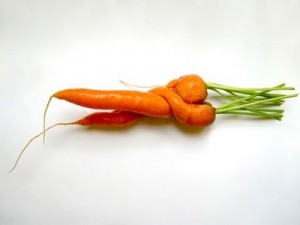 Funky Fruit. Marketing techniques are also applied to solve humongous (buzzable word score: 8.5) sustainability challenges. You should know by now that 30% of all food is tossed away before it even reaches our plates. Culinary Misfits is helping us see disfigured fruit & veggies in a new and very positive daylight. And although everyone involved should feel fuzzy and warm inside about their sustainable mission, you’re naive to believe this to be solely a charitable cause. There are billions to be made reducing food waste. Think what smart designers like Piet Hein Eek did with scrap wood. ‘Wasted’ wood now costs more than new wood. Not kidding here.
Funky Fruit. Marketing techniques are also applied to solve humongous (buzzable word score: 8.5) sustainability challenges. You should know by now that 30% of all food is tossed away before it even reaches our plates. Culinary Misfits is helping us see disfigured fruit & veggies in a new and very positive daylight. And although everyone involved should feel fuzzy and warm inside about their sustainable mission, you’re naive to believe this to be solely a charitable cause. There are billions to be made reducing food waste. Think what smart designers like Piet Hein Eek did with scrap wood. ‘Wasted’ wood now costs more than new wood. Not kidding here.
 Tomato Sponsors the Worldchampionships. If you’re still in doubt about the marketing potential of healthy produce, I just visited the World Championships Hockey and was greeted by the Westland Greenhouse pavilion that showcases vegetables coming from the Westland region. They target sport canteens to sell veggies. Judging from the success among kids and adults of their buzzable snack-tomato-box, they are on the right track.
Tomato Sponsors the Worldchampionships. If you’re still in doubt about the marketing potential of healthy produce, I just visited the World Championships Hockey and was greeted by the Westland Greenhouse pavilion that showcases vegetables coming from the Westland region. They target sport canteens to sell veggies. Judging from the success among kids and adults of their buzzable snack-tomato-box, they are on the right track.
 What’s next ? Supermarkets will sell ready-to-make meals with their functional (veggie) stories: extra energy, detox, relax. The first forgotten fruit & vegetables will stage their comeback under a shiny new brand. We will start to see international F&V brands for well known mass varieties. Seed companies, produce growers and retailers will be manouvering cautiously to capture more value through ownership of these brands. Star chefs will bring branded fruit & veggies to market under their name. It could have been Jamie, with his crusade for healthier school food but he decided to sell his soul to mediocre cooking utensils and teacups so ugly the teabag will jump out in protest. Finally, there is a lot of space for highly specialized fruit & veggie marketing agencies.
What’s next ? Supermarkets will sell ready-to-make meals with their functional (veggie) stories: extra energy, detox, relax. The first forgotten fruit & vegetables will stage their comeback under a shiny new brand. We will start to see international F&V brands for well known mass varieties. Seed companies, produce growers and retailers will be manouvering cautiously to capture more value through ownership of these brands. Star chefs will bring branded fruit & veggies to market under their name. It could have been Jamie, with his crusade for healthier school food but he decided to sell his soul to mediocre cooking utensils and teacups so ugly the teabag will jump out in protest. Finally, there is a lot of space for highly specialized fruit & veggie marketing agencies.
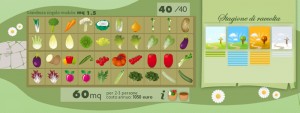 Farm around the corner. Possibly the biggest area of innovation and opportunities lies in production. The shift to more seasonal and local started long ago with restaurants like De Kas creating it own supply of fresh, organic veggies and turning it into an attraction wihin the restaurant. If you don’t have the space or the time, in Italy you can order your salad and carrots to be grown elsewhere using a handy online app with the possibility of adding your own photo on the scarecrow’s face (not kidding) for an extra 10 euro. If that’s not buzzable ; ) But it doesn’t stop there: what about an automated mobile ‘veggie-factories’ producing 10.000 vegetables a year in 20 different varieties ? It’s here.
Farm around the corner. Possibly the biggest area of innovation and opportunities lies in production. The shift to more seasonal and local started long ago with restaurants like De Kas creating it own supply of fresh, organic veggies and turning it into an attraction wihin the restaurant. If you don’t have the space or the time, in Italy you can order your salad and carrots to be grown elsewhere using a handy online app with the possibility of adding your own photo on the scarecrow’s face (not kidding) for an extra 10 euro. If that’s not buzzable ; ) But it doesn’t stop there: what about an automated mobile ‘veggie-factories’ producing 10.000 vegetables a year in 20 different varieties ? It’s here.
Now targeting restaurants, one could imagine a mini-farm like this in every block of a major city, like this one in Berlin that will produce fish and veggies. Jump to Danish supermarket Superbrugsen that is asking customers which local produce they would like sold in their stores. Combine the two and what do you get ? Retailers selling produce sold around the corner or producers around the corner turning into retailers.
 The ‘Maker’ movement wants us to go beyond consumption and produce ourselves. Many are starting to take this seriously. From building gardens on Dutch rooftops to self-watering veggie patches that you hang on your walls. From a Nasa-inspired rotating herb garden to the Sproutrobot service that ships you the seeds when you need to out them in the ground. And this is just the beginning, even if there are lots of qualified people arguing locally produced food does not help the planet.
The ‘Maker’ movement wants us to go beyond consumption and produce ourselves. Many are starting to take this seriously. From building gardens on Dutch rooftops to self-watering veggie patches that you hang on your walls. From a Nasa-inspired rotating herb garden to the Sproutrobot service that ships you the seeds when you need to out them in the ground. And this is just the beginning, even if there are lots of qualified people arguing locally produced food does not help the planet.
And yes, 3D Printed food ! If you combine local and personal production, you inevitably think 3D printing. Yes, also of food. With Oreo applying it as a marketing gimmick , the first serious food printers have arrived. And if that reminds you of Star Trek, you’re dead right, check out the clip below.
 What’s next ? With the Sharing Economy still steaming hot, why not start the AirBnB of shared vegetable gardens ? Free of charge, I give you a buzzable name for it: YourEden.com (a good name is always edgy). I see specialized Food printers entering high- end restaurants. And in the remote future you’ll have a ‘Dinify’ subscription to star chef recipes that you can print out on your Kickstarter funded Star Trek cooker. With food grown around the corner, expect the ‘subscription economy’ to hit fresh produce with a bang, as these Dutch and US examples of vegetable box subscriptions show. Distribution will go next: existing vending machines should see a next generation of ‘veggies on the go’ that are grown on the spot where you Go (just need to make sure the carrots don’t reek of gasoline). And the Internet of Things will arrive in your garden soon…
What’s next ? With the Sharing Economy still steaming hot, why not start the AirBnB of shared vegetable gardens ? Free of charge, I give you a buzzable name for it: YourEden.com (a good name is always edgy). I see specialized Food printers entering high- end restaurants. And in the remote future you’ll have a ‘Dinify’ subscription to star chef recipes that you can print out on your Kickstarter funded Star Trek cooker. With food grown around the corner, expect the ‘subscription economy’ to hit fresh produce with a bang, as these Dutch and US examples of vegetable box subscriptions show. Distribution will go next: existing vending machines should see a next generation of ‘veggies on the go’ that are grown on the spot where you Go (just need to make sure the carrots don’t reek of gasoline). And the Internet of Things will arrive in your garden soon…
Peter Diamandis argues that disruptive technologies will go ‘exponential’ after about 30 years of development. So are there any disruptive technologies, areas in fruit and veggies ? You bet. I present you with two guaranteed game changers. It would be fun to track back when they started.
 Seawheat ! An opportunity so relatively undiscovered, so huge that it’s hard to fanthom: vegetables from the sea. But ultimately, seafarming is a no-brainer: we can never feed 9 billion people off the land sustainably, the sea covers 2/3 of the planet, sea vegetables aleady grow everywhere and they are so healthy that exploding healthcare costs could be solved in one go. This is why some educated people are predicting that seaweed could become bigger than the 3 largest crops on the planet: rice, maize and wheat.
Seawheat ! An opportunity so relatively undiscovered, so huge that it’s hard to fanthom: vegetables from the sea. But ultimately, seafarming is a no-brainer: we can never feed 9 billion people off the land sustainably, the sea covers 2/3 of the planet, sea vegetables aleady grow everywhere and they are so healthy that exploding healthcare costs could be solved in one go. This is why some educated people are predicting that seaweed could become bigger than the 3 largest crops on the planet: rice, maize and wheat.
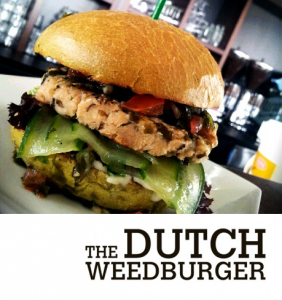 Ahead of the curve. For now, seaweed is a decoration, garnish on fancy restaurant dishes, an ingredient for animal food, soap and dozens of other products. Only the Japanese are ahead of the curve. And they’re right. I predict the farmer of the future will be riding a boat, not a tractor. Check out what that looks like in this video (good way to practice your Dutch). Last but not least: If you learn how to prepare different types of seaweed, you can create incredibly exciting new dishes and taste combinations. The crowdfunded Dutch Weedburger (maybe the Dutch are also a little ahead of the curve) is a nice example of that.
Ahead of the curve. For now, seaweed is a decoration, garnish on fancy restaurant dishes, an ingredient for animal food, soap and dozens of other products. Only the Japanese are ahead of the curve. And they’re right. I predict the farmer of the future will be riding a boat, not a tractor. Check out what that looks like in this video (good way to practice your Dutch). Last but not least: If you learn how to prepare different types of seaweed, you can create incredibly exciting new dishes and taste combinations. The crowdfunded Dutch Weedburger (maybe the Dutch are also a little ahead of the curve) is a nice example of that.
Plants replace Medicine. You have probably heard that legendary plants in far off Amazon jungles might cure cancer or any other disease. Enjoy Sean Connery busy curing cancer below.
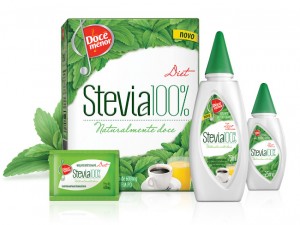 The war on Stevia. But it is much more real than you might imagine looking at Sean. With sugar posing an immediate threat to most of society’s health, a plant that can replace it is an immediate holy grail. And it exists. The Stevia plant promises sweetness but non of the health-risks that sugar does. Can you imagine the size of this opportunity. In my mind I see the plot unraveling. South American/Russian (sorry, stereotyping here) mobsters trying to steal the genetic code to the ultimate sugarplant or shady sugar corporates hiring hitmen to kill angel-like farmers that are sitting on vegetable goldmines.
The war on Stevia. But it is much more real than you might imagine looking at Sean. With sugar posing an immediate threat to most of society’s health, a plant that can replace it is an immediate holy grail. And it exists. The Stevia plant promises sweetness but non of the health-risks that sugar does. Can you imagine the size of this opportunity. In my mind I see the plot unraveling. South American/Russian (sorry, stereotyping here) mobsters trying to steal the genetic code to the ultimate sugarplant or shady sugar corporates hiring hitmen to kill angel-like farmers that are sitting on vegetable goldmines. 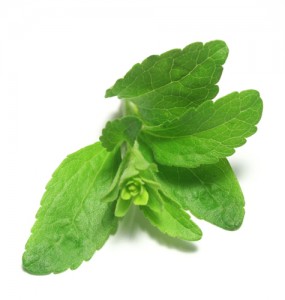 I tried the plant some time ago and was literally amazed by the taste of the leaves. With everything going natural, pack your bags and join the next Veggie Rush (imag gold rush). You will start to see Stevia popping up in the first consumer goods. Obviously, this is not just about Stevia. The Game Changer is plants replacing medicine/health care. While you read this, dozens of teams across the world are already in the middle of the plant rush.
I tried the plant some time ago and was literally amazed by the taste of the leaves. With everything going natural, pack your bags and join the next Veggie Rush (imag gold rush). You will start to see Stevia popping up in the first consumer goods. Obviously, this is not just about Stevia. The Game Changer is plants replacing medicine/health care. While you read this, dozens of teams across the world are already in the middle of the plant rush.
 What’s next ? Sea vegetables that become part of our normal eating routines and sea farming as a huge employment opportunity in various regions of the world. New diets with supercharged veggies that will replace medication in areas such as diabetes, powered by a Gold Rush for these miracle plants. It might even become the Big Pivot for pharmaceutical companies. I haven’t quite figured out how Big Data is going to converge with this sector ; )
What’s next ? Sea vegetables that become part of our normal eating routines and sea farming as a huge employment opportunity in various regions of the world. New diets with supercharged veggies that will replace medication in areas such as diabetes, powered by a Gold Rush for these miracle plants. It might even become the Big Pivot for pharmaceutical companies. I haven’t quite figured out how Big Data is going to converge with this sector ; )
So who is going to be the next Steve ?
I said I’d tell you who I believe is going to be the big winner in the Fruit & Veggie race. As I hinted, I doubt whether incumbent green giants such as the seed companies or a big produce grower will reap the rewards of the current paradigm shift. Without a doubt, they will flourish with the rise of the sector. The main reason they won’t lead is their lack of understanding of and experience with marketing and the consumer. Hiring a bunch of marketicionados won’t do them any good in the next few years, as they will clash with company culture. This happened to Google when it hired outsiders to introduce a design culture. Retailers will push for higher margins on their own private-label veggies and exclusivity for certain innovations but won’t go much further.
I believe a marketing-savvy entrepreneur that knows how to operate at the crossroads of technology and human psychology (that’s Steve for you) will be the third dog going off with the carrot. Undoubtedly, these new players will not own the entire value chain. If they’re smart, they’ll source from the seed companies and work with the producers. I’ve thought about an interesting business model since I discovered the Enza catalogue. If seed companies have such a treasure chest of innovations lying around on the shelves, why not acquire licenses on these and collect a virtual product portfolio to bring to market now ? Hell, I might just do that one of these days. Care to join me ?










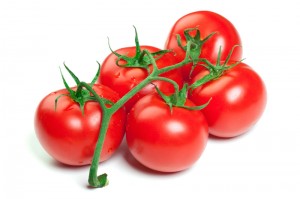



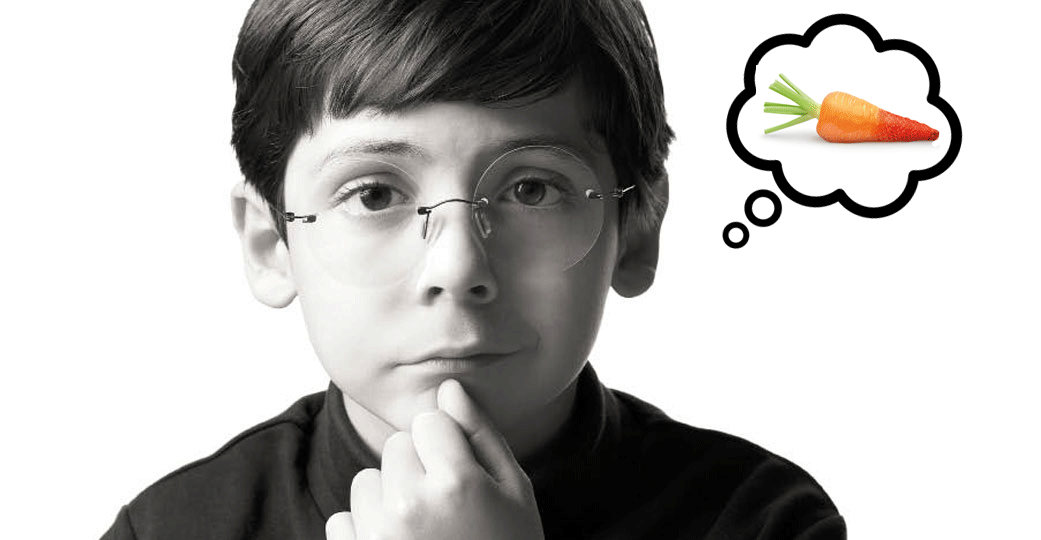
2 Comments Added
Join Discusion